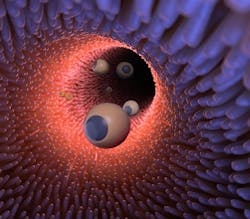Swallowable microrobot could enable targeted drug delivery
Seeking to simultaneously monitor and treat disease in hard-to-reach places in the body, two researchers in the California Institute of Technology (Caltech)'s Division of Engineering and Applied Science (Pasadena, CA) are developing swallowable microrobots that can deliver drugs to specific spots inside the body while being monitored and controlled via a photoacoustic method from outside the body.
The microrobots are a joint research project of Lihong Wang, Caltech's Bren Professor of Medical Engineering and Electrical Engineering, and Wei Gao, assistant professor of medical engineering, and are intended for treating tumors in the digestive tract. They consist of microscopic spheres of magnesium metal (which is biocompatible and biodegradable) coated with thin layers of gold and parylene, a polymer that resists digestion. The layers leave a circular portion of the sphere uncovered. The uncovered portion of the magnesium reacts with the fluids in the digestive tract, generating small bubbles. The stream of bubbles acts like a jet and propels the sphere forward until it collides with nearby tissue.
Taking it a step further to enable the magnesium spherical microrobots to deliver drugs, Wang and Gao made some modifications. First, a layer of medication is sandwiched between an individual microsphere and its parylene coat. Then, to protect the microrobots from the harsh environment of the stomach, they are enveloped in microcapsules made of paraffin wax.
At this stage, the spheres are capable of carrying drugs, but still lack the crucial ability to deliver them to a desired location. For that, Wang and Gao use photoacoustic computed tomography (PACT), a technique developed by Wang that uses pulses of infrared (IR) laser light. The light diffuses through tissues and is absorbed by oxygen-carrying hemoglobin molecules in red blood cells, causing the molecules to vibrate ultrasonically. Those ultrasonic vibrations are picked up by sensors pressed against the skin. The data from those sensors is used to create images of the internal structures of the body.
Previously, Wang has shown that variations of PACT can be used to identify breast tumors, or even individual cancer cells. By using PACT, the researchers can find tumors in the digestive tract and also track the location of the microrobots, which show up strongly in the PACT images. Once the microrobots arrive in the vicinity of the tumor, a high-power, continuous-wave near-IR laser beam is used to activate them. Because the microrobots absorb the IR light so strongly, they briefly heat up, melting the wax capsule surrounding them, and exposing them to digestive fluids. At that point, the microrobots' bubble jets activate, and the microrobots begin swarming. The jets are not steerable, so the technique is sort of a shotgun approach--the microrobots will not all hit the targeted area, but many will. When they do, they stick to the surface and begin releasing their medication payload.
Gao says that the next step is evaluating the therapeutic effect of the microrobots. He would also like to develop variations of them that can operate in other parts of the body, and with different types of propulsion systems.
Wang says his goal is to improve how his PACT system interacts with the microrobots. The IR laser light it uses has some difficulty reaching into deeper parts of the body, but he says it should be possible to develop a system that can penetrate further.
Full details of the work appear in the journal Science Robotics.
